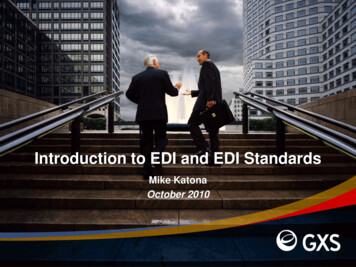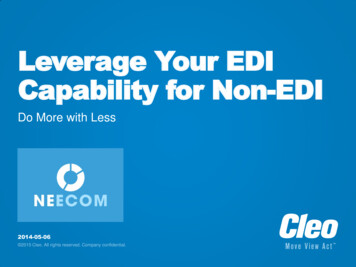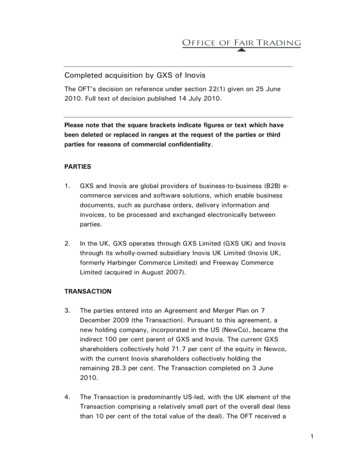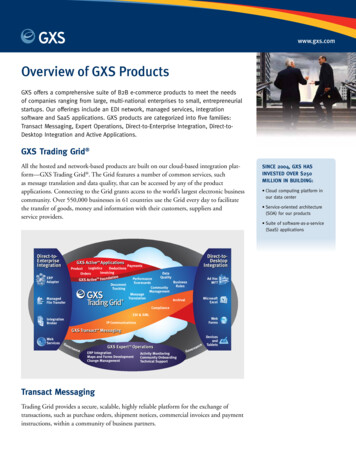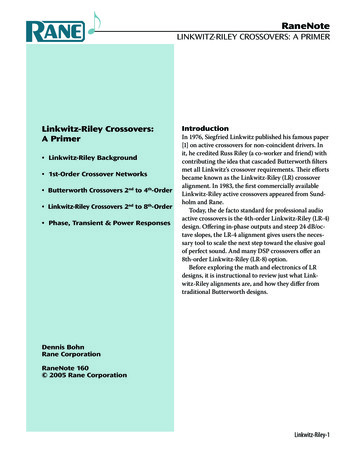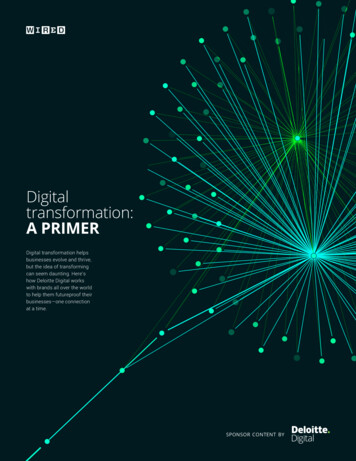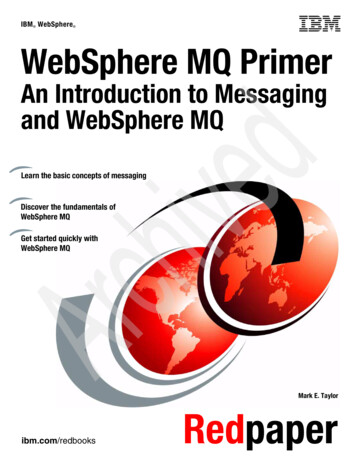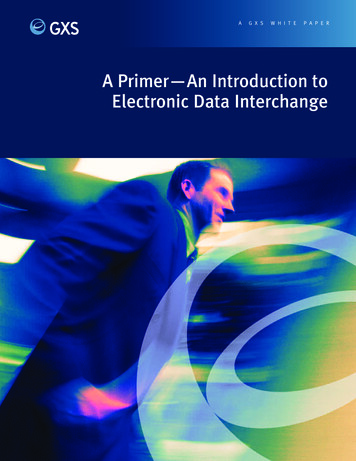
Transcription
AG X SW H I T EP A P E RA Primer—An Introduction toElectronic Data Interchange
Table of ContentsSection 1—A Definition of EDI .3What is EDI?.3Traditional Document Exchange .3The EDI Alternative .4Section 2—The Need for EDI .4The Business Need .5The Need for Speed.5The Need for Accuracy .6The Competitive Advantages of EDI .6EDI Provides Speed .7EDI Improves Accuracy.7EDI Reduces Costs.7EDI is Flexible .8EDI—An Integral Role .8Section 3—How EDI Works .8The Building Blocks of EDI.8The Data Element .9The Segment.9The Message .10The Envelope .11Putting the Blocks Together.12The Basic Steps of EDI.12Steps the Sender Must Take .13Steps the Receiver Must Take.14Options for Any Need and Budget.15Section 4—The Tools of EDI.15EDI Standards.15The Need for Standards .15Standards Bodies .15EDI Communications .16Value Added Networks .16VAN Benefits.16EDI Translation Software .17Translation Software Packages .17EDI Hardware Platforms .18Section 5—Implementing EDI.18An Overview of implementation .18Business Needs Analysis .18Requirements Definition.19Project Implementation .21Assessing the Benefits .22Section 6—Summary.22A Final Note .22Section 7—Terms and Definitions.242A PRIMER—AN INTRODUCTION TO ELECTRONIC DATA INTERCHANGEA GXS White Paper
Section 1—A Definition of EDIWhat Is EDI?In its simplest form, Electronic Data Interchange, or EDI, is the computer-to-computer exchangebetween two companies of standard business documents in electronic format. There are two keyelements in basic EDI. First, electronic documents replace paper documents. Second, the exchangeof documents takes place in a standardized format. Using these two basic concepts, any businesscan enter the world of EDI and begin taking advantage of the speed and economy of electroniccommerce.EDI DefinitionElectronic Data ExchangeWhat is EDI?Intercompany Electronic Exchange ofBusiness Documents in a Standard FormatIn today’s fast-paced business world, your business may already be moving in this direction.Customers or suppliers may already be approaching you to begin trading information electronically.To the newcomer to EDI, it may seem a very confusing topic. This Primer will provide you with anoverview of what EDI is, how it can benefit your business, and what the steps are that you willneed to take to become an electronic trading partner.Traditional Document ExchangeLet’s take just a moment to look at an example that highlights some of the differences betweentraditional paper document transactions and Electronic Data Interchange.One of the first places that many businesses implement EDI is in the exchange of a purchase order(PO). In the traditional method of processing a purchase order, a buyer or purchasing agent will gothrough a fairly standard procedure to create a purchase order, consisting of these steps: A buyer reviews data from an inventory or planning system. The buyer enters data into a screen in the purchasing system to create a PO. The buyer waits for the PO to be printed, usually on a special form. After the PO is printed, the buyer mails it to the vendor. The vendor receives the purchase order and posts it in their order entry system. The buyer calls the vendor periodically to determine if the PO has been receivedand processed.A PRIMER—AN INTRODUCTION TO ELECTRONIC DATA INTERCHANGEA GXS White Paper3
When you add up the internal processing time required by the sender and receiver, and then adda couple of days for the mail, this process normally takes between three and five days. Thisassumes first that both the sender and receiver handled the PO expeditiously, and that at everypoint along the way there are no errors in transcribing data from a form to a system.EDI Concepts—Why EDI?Why EDI? To change this:BuyerBurst Fold Errors Sort Errors Time Mail Stuff in Envelope Sort Time Time Stamp Open Envelope Seller Input Read Errors Time RouteThe EDI AlternativeNow, consider the same document exchange when a company places its purchase orderselectronically using EDI. The buyer reviews the data and creates the purchase order, but does not print it. EDI software creates an electronic version of the PO and transmits it automatically to thesender within minutes. The vendor’s order entry system receives the PO and updates the system immediately uponreceipt. The vendors order entry system creates an acknowledgment and transmits it back to thesender to confirm receipt.What took up to five days with paper and the postal system has just taken less than one hour. Byeliminating the paper handling from most of the stages of the process, EDI transforms the traditional paper process to look like this:EDI Network MailboxBuyerFast Accurate Dependable4A PRIMER—AN INTRODUCTION TO ELECTRONIC DATA INTERCHANGEA GXS White PaperSeller
This fairly simple example illustrates just one of the many ways that businesses can profit by theimplementation of Electronic Data Interchange. In the following section, we’ll look at some of thereasons why EDI is becoming a necessity for conducting business in today’s economy.Section 2—The Need for EDIThe Business NeedReplacing paper documents with electronic ones will necessarily require changing the way youdo business. In the simple example described above, replacing a paper purchase order with anelectronic one will provide several obvious benefits. It will also have an impact on the way youorder your supplies. It will mean replacing your current paper system with a very different wayof doing business.Since changing the way you do business is not a task you will undertake casually, you mightwonder at this point why you should upset a process and procedures that work well. In today’sglobal economy, every business faces constant pressures to improve the quality of its productsor services, while at the same time tightly controlling or reducing costs. While computer information technology has automated or streamlined many internal processes, in many businesses theexternal processes of exchanging information with customers and suppliers still lag far behindthe internal procedures. The need for speed and accuracy in these external processes is becomingever more critical.The Need for SpeedSpeed, whether in the increased velocity of moving products from design to the market place, orin the rapid response of a supplier to customer demands, is vital to success. Increased speed canbenefit a business in several ways: Shorten lead times for product enhancement or new product delivery. The market advantage of months or even weeks can have a major impact on profitability. Do more with less. Staff reductions, commonplace in many businesses, require that fewerpeople accomplish more work. Handling exchange of data electronically may be critical tosurvival, giving employees the tools to be more productive while reducing overhead. Reduced delivery cycle times mean reduced lead times and lowered inventory carryingcosts.The Need for AccuracyAccuracy in the exchange of business documents is always important. The traditional paper document exchange requires information transfer through transcription or data entry, and any suchinformation transfer will introduce errors into the process.A PRIMER—AN INTRODUCTION TO ELECTRONIC DATA INTERCHANGEA GXS White Paper5
Increases in speed are often difficult to attain because of the need to avoid transcription errors. Asspeed increases, so does the likelihood of error. Advantages gained by increases in velocity may beeasily offset by the high cost of error correction.There are several obvious cost savings that will result from increased accuracy of information transferred to suppliers and customers: Increased customer satisfaction Reduced overhead required either to detect or to reprocess erroneous documents Reduced costs to expedite goods or services that are late or lostThe Competitive Advantages of EDIEDI is the tool that can enable businesses to achieve dramatic increases in speed, while theyrealize at the same time the benefits of improved accuracy in the transfer of critical information.Documents transferred directly from computer to computer move in orders of magnitude morequickly than paper documents, with no loss of accuracy.Because paper documents have been replaced with electronic transactions, it is easy to maintain electronic logs or audit trails of document handling activity. From this, businesses gain a substantialincrease in the ability to track status and measure performance throughout the entire process.Let’s take a closer look at some of the benefits of the example mentioned above to highlight theadvantages of the electronic process over the traditional paper process. The process takes minutes or hours instead of days. The PO goes from the buyer’s computer through a network to the vendor’s computer withno human intervention. There is no need to copy or transcribe the PO upon receipt, eliminating the possibility of data entry error. The electronic document has not been handled by any mailroom staff, postal or deliveryservice, or data entry staff. It will not wait in any in-basket, and it won’t have to wait whilestaff are on the phone. The buyer receives rapid confirmation of PO receipt.These facts can translate directly into cost savings resulting from reduced cycle times, reduced overhead, and improved accuracy. In today’s business environment, companies cannot afford to ignorethese benefits.6A PRIMER—AN INTRODUCTION TO ELECTRONIC DATA INTERCHANGEA GXS White Paper
EDI Provides SpeedUsing EDI will provide specific and measurable increases in the speed of document transfer, withaccompanying decreases in document cycle time. Sending an electronic message across the country or around the world requires onlyseconds or minutes as opposed to days. Such transmissions typically occur at over 1000characters per second. Data is available immediately for use in internal applications. Data, once received, needsonly to be translated internally into the specific format required by the receiver’s applicationsoftware, and it is ready for use. Reduced business cycle times provide a competitive edge in any business.EDI Improves AccuracyElectronic transfer of data eliminates the need for copying data from one paper document toanother, or for keying the data into a business application screen. Every time data is transferred,there is opportunity for error. In the typical manual purchase order, a person enters or copiesinformation from the paper form at least once. With EDI, improved accuracy is obtained inseveral different ways: Electronic data is usually derived from a database, where data has been subject to priorvalidation; Electronic documents are transferred accurately regardless of size. If transmission of a largedocument is not successful, users can invoke re-transmission procedures rapidly; Even if several different parties process the electronic document, with each party adding datato the existing document, none has the ability to alter previously entered information.EDI Reduces CostsYour business may obtain a variety of cost reductions as a result of implementing EDI. Thesereductions can include both cost savings and cost avoidance. These points summarize just a few ofthe more general types of savings you can expect: Reduction of overhead costs by eliminating human handling in such areas as mailroomsorting and circulation, clerical document preparation, and data entry. Substantial cost savings can result from reduced error rates. These savings include savings inlabor costs normally used to search for errors, and in lowered expediting costs. Reduction of inventory costs through shortened order processing and delivery cycles,and generally lowered inventory levels. Lowered inventory levels result in correspondingreductions in carrying costs. Inventory costs can, in some businesses, account for as muchas 90 percent of total product cost, so even modest reductions in this area can result indramatic savings.A PRIMER—AN INTRODUCTION TO ELECTRONIC DATA INTERCHANGEA GXS White Paper7
EDI Is FlexibleA business can implement EDI transactions in a phased-in approach, allowing a business to targetspecific areas for immediate improvement, while migrating gradually to full implementation.EDI: An Integral RoleEDI has become a powerful management tool for increasing velocity and achieving benefits ofspeed, accuracy and cost reduction. Many companies are requiring their vendors and suppliers toenter into electronic information trading relationships.Section 3—How EDI WorksThe Building BlocksThe previous sections described what EDI is, and some of the ways it can be beneficial to anybusiness. It is important to understand some of the fundamentals of the EDI process in order tomake sound choices when the time comes to begin the implementation in your own business.This section will provide an overview of how EDI works.First, we will take a look at what composes an EDI document then we will describe how abusiness can make use of the basic building blocks to send a document electronically.The challenge of defining the electronic document is that it must be specific enough to be able toserve the needs of any business without imposing unnecessary requirements. Because it must bedone by computer, there can be no ambiguity. Each required piece of information requires explicitdefinition.For example, if you are sending an electronic purchase order, the paper document must be translated into a specific standard formal (e.g., ANSI X.12 or EDIFACT) for purchase orders. This needto define everything down to the last period and comma leads to a necessary amount of detailthat may seem a bit bewildering on first glance. An overview of what the pieces are and howthese pieces fit together should help eliminate some of the mystery about what an EDI documentactually is. We’ll begin by describing the basic building block of all EDI messages—the DataElement. Then we’ll review how these elements are combined into Segments, which in turn formsMessages that are transmitted in electronic Envelopes.8A PRIMER—AN INTRODUCTION TO ELECTRONIC DATA INTERCHANGEA GXS White Paper
From: 4581640Y1587Cellulose SpongesPlastic PailsYellow Dish Drainer6” Plastic Flower Pots12.75.457.943.08ANSI X12 Standard FormatTo: IT1*1*3*CA*12.75*VC*6988 N/LIT1*2*12*EA*.457*VC*P458 N/LIT1*3*4*EA*.94*VC*1640Y N/LIT1*4*1*DZ*3*VC*1587 N/LTranslation from “Human Readable”to a “Machine Readable” StandardFormatThe Data ElementThe basic building blocks of an electronic document are data elements, which represent unitarypieces of information. An address is not a data element, because it can be broken down into severalelements such as street address, city, state and country. Each of these pieces of information cannot befurther divided, and therefore represent elements. A phone number is an example of data that can befurther divided into elements such as country code, area code, and local number.The data element definition will describe: The type of data (numeric, alphanumeric, date, time) The minimum and maximum length allowed Code or conditional values that must be observed with a particular type of dataDefinition of a data element for unit cost would allow you to st
Basic Steps of EDI Inbound Translation Translator Software Translator Software Outbound Translation Value Added Network Processing Electronic Documents Document Preperation Inbound Communicat
